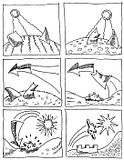Draw eight panels on a large piece of paper. (I will, however, demonstrate in digital images). In the first panel draw three distinct shapes. Let's call them 1, 2 and 3.

(obviously the numbers are not going to be in the final image.)
For the next panel, one of the shapes (let's call it shape # 3) stays in place, in exactly the same spot and orientation as in the first panel. Another one of the shapes (let's call it shape # 2) moves to the other half of the panel ("other half" can be defined as you wish--that is, crossing over the vertical, the horizontal, and even one of the diagonal axes), and rotates. Finally, the last shape (let's call it shape # 1), is replaced by a completely new shape (let's call it shape # 4), which you can place wherever in the panel you see fit.

For the third panel, apply the same transformation to panel 2: the shape with the highest number (ie the newest shape) stays put, the shape with the second-highest number changes place and orientation, the shape with the lowest number is replaced with a new shape.

And so on, from panel to panel.
Now, obviously this can continue indefinitely. You can go on for one page, or two, or one hundred. Let's stay with one page for now. To conclude, introduce in the next-to-last panel shape # 1, and in the last panel shape # 2, so that the last panel can flow directly back into the first panel.
Now, there is one more part to this exercise. After you have placed the shapes in all panels, add four (and exactly four) lines to each panel. The lines can be as long as you want, but they cannot curve more than 180 degrees, and they cannot contain more than two curves (i.e., the most complex line you can put in is an S). Of course, they can also be plain old straight lines. Add them to give dynamism (movement lines), to provide a horizon line, etc., but basically to help each panel in some way flow into the next, or give some kind of rhythm to the overall sequence.
Here is my end result (clickable):

Here is the sketchbook page on which I worked this out, a few years ago:

And here is a variation on it, with more lines added, also from my sketchbook:

If anybody reading this feels like trying their hand at it, send me the results, and maybe I'll gather them and publish them as a mini for MoCCA.
BTW, the shapes I used in explaining this have a whole story of their own, but that's for a different post.

it is fairly difficult not to see each shape as representative of an organism, and to imagine human-like interactions (with motives) between them from panel to panel. it reminds me of the game "flow" or "spore," populated by identifiable abstract amoebae.
ReplyDeleteAnd extending that thought, as soon as we move to anthropomorphization, we step away from abstract comics, it seems. The result would instead seem to be regular comics with atypical characters (similar to McCloud's micro-biology comic: http://scottmccloud.com/1-webcomics/mi/mi-05/mi-05.html).
ReplyDeleteOf course, I'm new to "abstract comics" so I may have stepped out of definition-bounds....
Except that I would say in this case you are the one bringing the anthropomorphization to the comic, aren't you? It's still a play of shapes--and, admittedly, one can choose to use the extra four lines to either create, say, a horizon line (thereby creating a setting), make motion lines (thereby infusing the shapes with life), or to create a pure abstract pattern still.
ReplyDeleteUltimately, the sense of "narrative" is not created by a pre-established plot, but still by the arrangement of shapes and how they change from panel to panel--which is still closer to "abstract" (but also see my comment under Noah's post, "Neither abstract nor comic. Discuss.")
Besides, if they're right on the edge between abstract and figurative, that's fine by me. I will post soon another, more properly "abstract" classroom exercise.
You're crazy.
ReplyDeleteBut I like it.